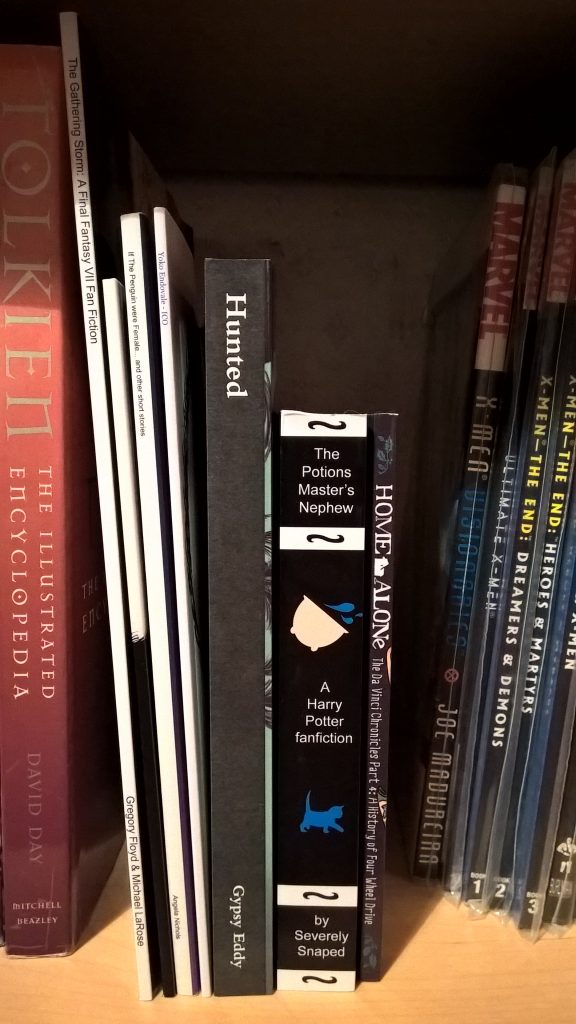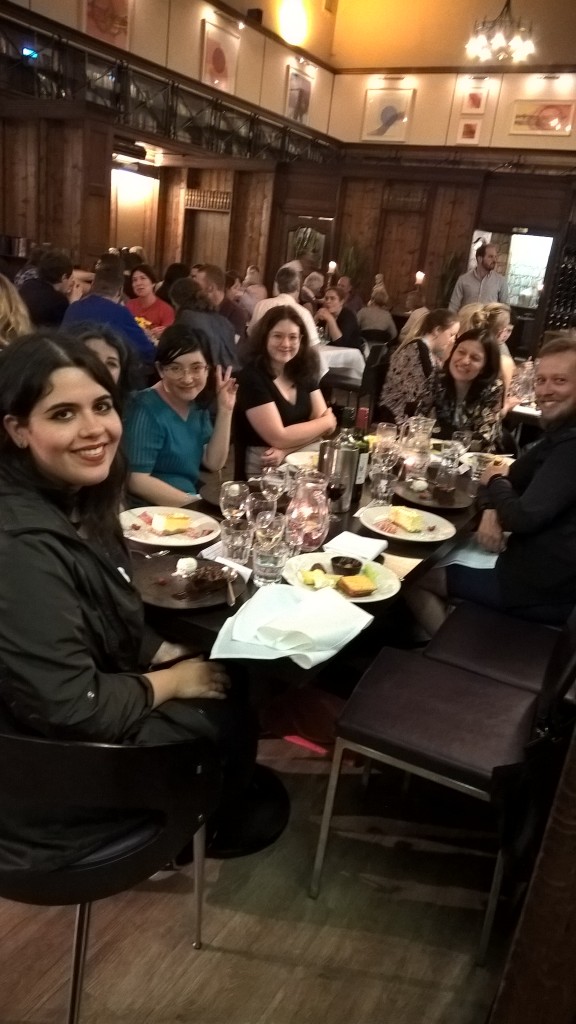 Ten years ago Abigail De Kosnik introduced her concept of ‘archontic literature’, which describes fan texts (and indeed many other texts in the canon of Western literature) as additions to a global archive of cultural texts, an archive that writers draw upon to create their own works, thus expanding and enriching the archive that already exists (Derecho, 2006). Works such as Death Comes to Pemberley by P. D. James build upon the ‘archive’ of Jane Austen’s Pride & Prejudice narrative; Tom Stoppard’s Rosencrantz and Guildenstern are Dead builds upon Shakespeare’s Hamlet; countless tales around the world build upon the archive of ancient folklore and mythology that have enthralled us across many eons. As a student of Library and Information Science (LIS) – and an avid fanficcer – the idea of fan texts as literal and figurative documents in an ever-growing and ever-expanding archive of human culture immediately appealed to me. The appeal grew to reinforce my opinion – or intuition – that LIS and fandom are intrinsically intertwined. For if fanfiction is archontic literature, part of a grand cultural archive, who then are the archivists? The answer, of course, is the fans themselves.
Ten years ago Abigail De Kosnik introduced her concept of ‘archontic literature’, which describes fan texts (and indeed many other texts in the canon of Western literature) as additions to a global archive of cultural texts, an archive that writers draw upon to create their own works, thus expanding and enriching the archive that already exists (Derecho, 2006). Works such as Death Comes to Pemberley by P. D. James build upon the ‘archive’ of Jane Austen’s Pride & Prejudice narrative; Tom Stoppard’s Rosencrantz and Guildenstern are Dead builds upon Shakespeare’s Hamlet; countless tales around the world build upon the archive of ancient folklore and mythology that have enthralled us across many eons. As a student of Library and Information Science (LIS) – and an avid fanficcer – the idea of fan texts as literal and figurative documents in an ever-growing and ever-expanding archive of human culture immediately appealed to me. The appeal grew to reinforce my opinion – or intuition – that LIS and fandom are intrinsically intertwined. For if fanfiction is archontic literature, part of a grand cultural archive, who then are the archivists? The answer, of course, is the fans themselves.
In Rogue Archives, De Kosnik updates the concept of ‘archontic literature’ to ‘archontic production’, crucially expanding it to include other forms of fanwork that do not involve creative writing, such as fanart, fanvids, fanfilms, podfic, cosplay, mods etc. This expansion of the ‘archontic’ concept here is much more satisfying in that it brings in the entire range of fan production and allows it a space within the cultural archive. Fanfiction is no longer given precedence but is simply a part of the sum of fandom’s archontic outputs. Whilst the expansion of the term bolsters its theoretical implementation, it also brings it more in line, both conceptually and metaphorically, with actual archives, which of course are not merely repositories of the written word.
As far as I know, Rogue Archives is the only book that explicitly links LIS to fandom. Within fan studies, there have been several articles that comment upon classification practices and information behaviour within fandom (e.g. Versaphile, 2011; Johnson, 2014; Thomas, 2016), although few draw explicitly upon the field of LIS and its methodologies to do so. Likewise, the field of LIS has done little to engage with fan information practices, despite a growing interest in information behaviour within leisure contexts. LIS literature on fan information behaviour is few and far between, though some does exist, e.g. Hart et al. (1999), Adams (2009), and Bullard (2014; 2016), albeit with limited impact. What Rogue Archives does is unequivocally link the language of both disciplines (admittedly with a focus on the fan studies angle, which is understandable given the context of the book) for the first time. From my perspective at least this is a welcome surprise, if only to reaffirm that I’m not in a club of one.
What is also fascinating about Rogue Archives is the fact that it also incorporates concepts from performance studies – an angle which the library school I’m studying at, #citylis, is also heavily interested in (we recently held a symposium, Documenting Performance, which brought together parties from both performance studies and LIS to discuss the ways in which we (can) document complex documents such as live performance). De Kosnik’s book was an enlightening foray into the idea that fanworks sit squarely on the boundary between the documents of the traditional analogue archive, and the embodied, temporal works of the performance arts. There is an apparent dichotomy between what we call the archive and what De Kosnik and others call ‘repertoire’, as she explains:
“Repertoire” transmits knowledge through processes of embodied mimesis, one person imitating what another person does, while “archive” transmits knowledge through recording technologies […], one person decoding the knowledge that another person has encoded in fixed form. (p.54)
What Rogue Archives does is to break down this seeming dichotomy, by showing how fans use both traditional archival practices and repertoire in order to build the ‘rogue archives’ that fan archives encompass (i.e. they are universal, community-driven and alternative). Whilst fan archives, such as FF.net and AO3, do seem to be like the usual digital archives on the surface, they reject many of the practices employed in traditional archives. There is no formal collection policy; archivists are ‘techno-volunteers’ who learn their tasks through repertoire, through following the example of more experienced fans or mentors. They are based on passionate practice rather than professional practice. They represent active cultural memory rather than passive cultural memory.
What is important here is that popular culture is constantly moving, evolving. Fanworks (which are now largely born-digital) are also constantly shifting and dynamic. They are subject to the whims of their creator, constantly edited, abandoned, unfinished, remixed, reworked, deleted, lost. Ephemeral, dynamic and rarely instantiated in a single, fixed form, fanworks share much in common with performance art and it is therefore difficult to submit them to the rigidity of formal archival process. This affinity with complex documents leads fan archivists – ‘techno-volunteers’ as De Kosnik calls them – to effectively bridge the gap between the immovable, analogue world of the traditional archive, and the performative, non-reproducible world of repertoire.
De Kosnik is skeptical of what LIS can do for fandom. As she notes herself, fans have been “dedicating themselves to digital cultural memory work [since] the early 1990s, just as the Internet and the World Wide Web were becoming integral to daily life” (p.12) – ironically, fans have been digital archivists a lot longer than digital archivists have, and have the corresponding expertise. This is mirrored in the responses of some current LIS students I surveyed earlier this year for my ‘Fanfiction in the Library‘ paper, delivered at FSN2016 in June (Price & Robinson, 2016). There was the idea that fans manage their own archives ‘just fine’ themselves. There is also a wariness of LIS imposing itself on the practices fans have already developed in order to preserve their own cultures. That is why I believe that any attempt at collaboration should involve the utmost respect and understanding on the part of LIS in preserving digital fan culture. It is also why I believe that there is a lot LIS can learn from fans, which is why I am researching what I am – and which is what Rogue Archives proves in spades. I am reminded of the Games Culture Summit earlier this year, where one of the speakers talked about her institution working with gaming fans on the best methods for archiving and preserving videogames. I think this serves as an encouraging example of what can be achieved when fans and LIS professionals work together. Pooling together our different but equally important expertise can help create a ‘best practice’ for the preservation and organisation of a growing type of complex and/or dynamic materials that LIS professionals are currently finding a real challenge to deal with.
At the very least, what Rogue Archives proves to LIS is that ‘serious leisure’ (Stebbins, 2001) has been the breeding ground for many new, innovative and significant ways of preserving human culture, methods that it has taken little notice of in the past, but that may yet be able to inform the discipline’s future.
References
- Adams, S. (2009). What games have to offer: information behavior and meaning-making in virtual play spaces. Library Trends [e-journal] 57 (4). Available at: http://dx.doi.org/10.1353/lib.0.0058
- Bullard, J. (2014). Values and negotiation in classification work. CSCW’14 Companion. Baltimore, USA, 15-19 February 2014 [online]. New York: ACM. Available through: ACM Digital Library
- Bullard, J. (2016). Motivating invisible contributions: framing volunteer classification design in a fanfiction repository. Proceedings of the 19th International Conference on Supporting Group Work – GROUP ’16. New York, USA, 13-16 November 2016 [online]. New York: ACM. Available through: ACM Digital Library
- De Kosnik, A. (2016). Rogue archives: digital cultural memory and media fandom. Cambridge, MA and London: MIT Press.
- Derecho, A. (2006). Archontic literature: a definition, a history, and several theories of fan fiction. In: K. Hellekson & K. Busse (eds.), Fan fiction and fan communities in the age of the internet. Jefferson: McFarland, Ch. 1.
- Hart, C., et al. (1999). The bibliographical structure of fan information. Collection Building [e-journal] 18 (2). Available through: Emerald Insight
- Johnson, S. F. (2014). Fan fiction metadata creation and utilization within fan fiction archives: three primary methods. Transformative Works and Cultures [e-journal] 17. Available at: http://dx.doi.org/10.3983/twc.2014.0578
- Price, L., & Robinson, L. (2016). Fanfiction in the Library. Fan Studies Network Conference 2016, Norwich, Norfolk, UK, 25-26 June 2016.
- Stebbins, R. A. (2001). Serious leisure. Society, [e-journal] 38 (4). Available through: Springer Link
- Thomas, P. (2016). Wikipedia and participatory culture: Why fans edit. Transformative Works and Cultures [e-journal] 22. Available at: http://dx.doi.org/10.3983/twc.2016.0902
- Versaphile (2011). Silence in the library: Archives and the preservation of fannish history. Transformative Works and Cultures [e-journal] 6. Available at: http://dx.doi.org/10.3983/twc.v6i0.277





